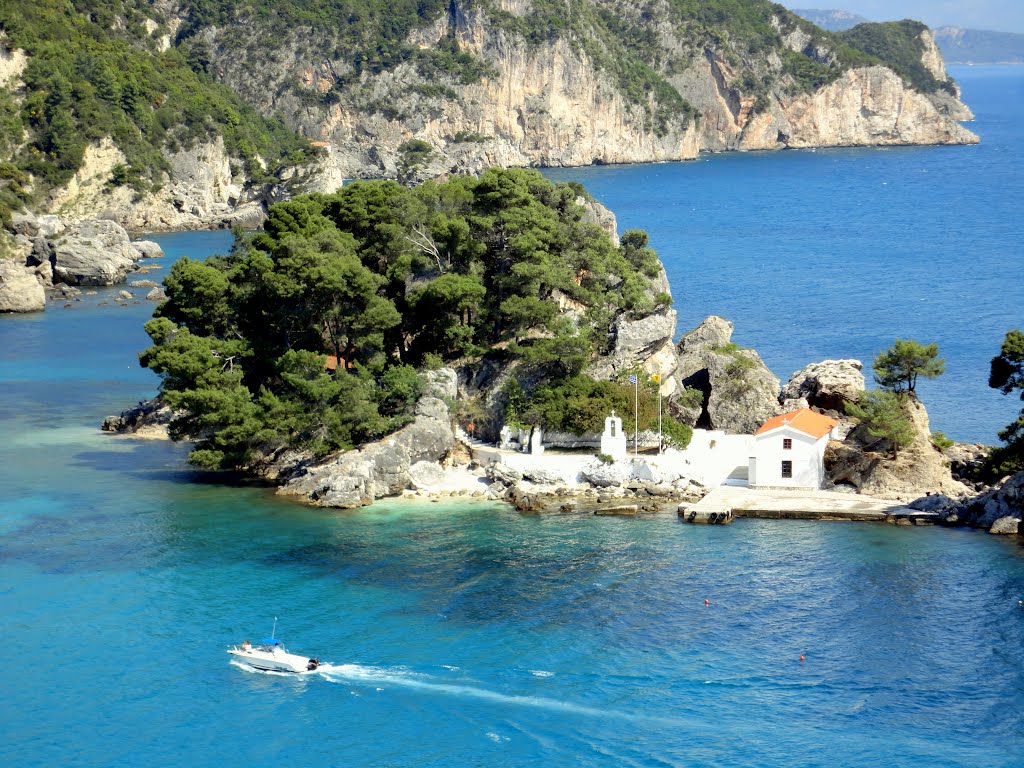
Parga
 |
Parga belongs to the prefecture of Preveza and is situated in the coastal area of northwest tip of Thesprotia region. Across the coast the visitor can see the islands of Paxos and Antipaxos. Distant only 68 km from the town of Preveza and 50 km from the city of https://en.wikipedia.org/wiki/Igoumenitsa. Parga was built amphitheatrically between the coastal shores of the Ionian Sea and the foothills of Parga. |

Ancient and Roman times
Today, Parga is built on the rocky and steep peninsula where according to Ptolemaios and Plutarch was the hellenistic town of Toryni, which appears to have survived until the late Roman period and that remained administratively dependent from the Roman colony of Fotiki. The Toryni possessed a very important geopolitical position with majestic geoeconomics capabilities. Specifically was able to control by land all the Roman roads leading from the coast to the hinterland (in plains of Margariti) and by sea the two bays, Valtos and Kryoneri, where all passing ships followed the ancient international sea route Apollonia-Butrint-Nicopolis. Finally, Toryni was placed in an area that should be like today, full of olive trees and the sea should offered to it’s residents rich and potential opportunities for growth of sea trade in region.
Byzantine (Medieval) and earlier times
| It is said that Parga was an important settlement from the Byzantine period. Local tradition narrows that Parga until the mid-14th century was built on the mountain Betzovolios close to the city’s castle. According to local stories a shepherd accidentally found on the beach the presumed lost ecclesiastic image of Madonna of the Church of Odigitria. Along with the rest of the residents placed it back to church but the holy image disappeared again. This led the residents to transfer the settlement from the mountain to spot where the shepherd found the holy image.
The area in medieval times was attacked numerous times by pirates and bandits. Peaceful times came in the late 16th century up to the late 18th century. |
 |
In 1401 the city went under Venecian control with a treaty between the two cities, where it remained until 1797. During the Venecian administration control Parga was fortified as it’s castle was built, became the commercial center (at Valtos visitors can still see the ruins of the Ntogana, was the era Customs) and acquires privileges and envloves economically. Meanwhile, the Venecians ordered the local to plant olive trees, resulting a substantial part of Pargians to be involved in olive oil production. Parga, as in Preveza, operated oil mill (mills) and, soap production. In same period was developed an important educational movement with pioneers renowned teachers such as monk Philotheos, Anastasios Mospiniotis, Andreas Idromenos and Christoforos Perraikos, Agapios Leonardo, etc. In 1797 passes under French and soon under English administration. The English then sell the whole region to Ali Pasha with the Treaty of 1800 and the city loses the privileges gained in the past. The Pargians reacted to the Treaty, as they lost a significant part of their property. In 1913 the city is part of the Greek state.
The small two-storey houses with wooden balconies and with theirs tile roofs are connected by narrow streets (alleys) present the modern architecture image of the city. The townspeople used to build their houses very close to each other while the houses located on the outer side of the city had battlements to protect them from outsiders. Thus, the city had a defensive character, which is evidenced by its architecture even today.

 |
Magestic is the green island of Panagia, situated in front of the port of Parga with it’s small church and French built castle.. |
The Parga churches have the same architectural features with the rest of the residential fabrications. Parga presents a very large number of churches, as many invasions and attacks accepted, made the residents to turn to their religious feeling and security that it offers. The churches that were outside the city had loopholes for defensive purposes. To the west of the city, in Cheladio cape is the Monastery of Vlacherna, majestic building of the Byzantine period with a tall steeple, which according to tradition had nine bells when struck sounded from a distance of 12 miles. Notable also is the church of St. Nicholas (patron Parga), which is the largest city, the St. Helena church (Hill St. Helena), the church of Agios Athanasios (Krioneri), the church of Agios Sostis (St Sostis – beach ), the church of Agia Marina, the church of Panagia (the islet), the church of St. Nicholas (in Chaliopoulo), the church of St. Nicholas (Monolithos), the church of the Twelve Apostles where there are the relics of Parga sacred banner, gospels, images and utensils, the St. Spyridon church (the Swamp). price, which stands at the highest point of the island.

| Parga’s seasides are well known in whole world and many of them as: Krioneri, Valtos, Lichnos, Sarakiniko, Ai-Giannaki, can offer sea sports, sailing, water activities etc.
The city is close to many other famous seasides like Mikri & Megali Ammos, Zavia, Zeri, Mpella Vraka, Karvouno, Ag. Paraskevi, Kanalaki, Perdika etc. Each summer, Parga is full of tourists as it offers all the appropriate accommodation services with many hotels, camping sites, restaurants, bars, clubs, etc. |
 |
Source: Wikipedia |

